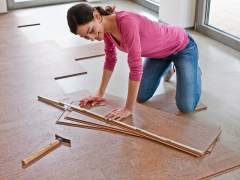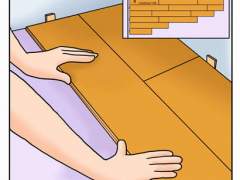Cork is an effective and environmentally friendly material and it is quite simply to lay it with your own hands.
 Cork flooring has become recently applied. But, despite of a relatively new material, its use is growing in popularity. Many manufacturers have developed a full and relatively inexpensive substitute for natural veneers of cork, so every person who has minimal skills of repair with own hands may easily find out how to install cork flooring.
Cork flooring has become recently applied. But, despite of a relatively new material, its use is growing in popularity. Many manufacturers have developed a full and relatively inexpensive substitute for natural veneers of cork, so every person who has minimal skills of repair with own hands may easily find out how to install cork flooring.
However, this coating should not be laid everywhere. Therefore, before purchasing the material you should understand what a cork floor is. Otherwise you risk ruining an expensive material and just waste time on installation.
By the way of its styling, all floor coverings of cork are divided into two types – adhesive and floating cork flooring. Accordingly, each of these types has its own technology of the installation.
It should immediately be noted that the technology of cork flooring installation in the floating way is very similar to the laminate stacking technology, and if you’ve previously seen how it’s done, it will not be difficult for you.
How to lay cork cover by own hands
First of all, you need to cover the entire area of prepared earlier polyethylene. You need to do overlap on joints, which shall not be less than 8 inches. All joints must be glued down with tape. The material overlap on the walls of the room should be slightly above the height of the alleged baseboard. (Then the polyethylene can be cut off or hidden behind the baseboard).
Laying floating cork floor
Cork flooring can be installed on any solid surface: concrete, board, plywood, parquet, and over ceramic tiles. You can not perform cork flooring installation right on concrete, especially on uneven concrete, so you need a substrate. A substrate must be put on the polyethylene, which is necessary to smooth the error of floors, as well as to mitigate a possible knock of the element on the base during the move. A substrate is laid back to back, and the connection is still glued down with a scotch tape.
and over ceramic tiles. You can not perform cork flooring installation right on concrete, especially on uneven concrete, so you need a substrate. A substrate must be put on the polyethylene, which is necessary to smooth the error of floors, as well as to mitigate a possible knock of the element on the base during the move. A substrate is laid back to back, and the connection is still glued down with a scotch tape.
After the substrate is laid, it is necessary to make some measurements. During installing cork panels it can happen that the last stacking row will have a very small width. The thickness of less than 2 inches is unacceptable. Therefore it is necessary to perform measurement of the width of the room perpendicular to the intended laying direction.
Corner assembling
The resulting width is divided by the width of one panel element. Thus, you should make sure that the last stacking number will have a width bigger than 2 inches. Otherwise, it is necessary to slightly trim a panel of the first row along the part of the ridge.
The first panel is laid by ridge to the wall and secured using the wedge. Between the cork covering and wall it is necessary to leave the so-called expansion gap, which should be between 0,2-0,4 inches. Such a gap during installation can be controlled by wedges.
You need to start laying of each next row with pruning, which should be from the last bar of the previous row. If the remaining scrap is too small or does not remain at all, it is necessary to cut a piece from a new panel, but remember that this piece should be at least 8 inches. And remember that the distance between the short seams of panels has to be at least 8 inches.
Docking of panels
Docking cork panels is produced as following: each element of the next row at an angle of about 35-45 degrees is inserted in the previous groove, and then carefully lowered to its normal position. Then lay the panels in this position by sliding as long as it does not dock with other short panel side of its row.
 Slide the panels easier and more correctly insert a pre-prepared for this scrap into the lock, causing light strikes on trimming by a mallet. All of these panels are placed similarly.
Slide the panels easier and more correctly insert a pre-prepared for this scrap into the lock, causing light strikes on trimming by a mallet. All of these panels are placed similarly.
If there are heating pipes or any other obstacles in the floor base, it is not necessary to drill holes in the cork panels, which is called tailgating. Between such elements you need to leave a gap of 0,2-0,4 inches.
To dock elements of a cover in the doorway, you must use a special profile, which is called the threshold. However, the profile should not be attached to the panels themselves. It is attached directly to the base in the gap, which must be left between the panels.
Once all the panels of cork floor are laid, all the spacing wedges must be removed that you used while laying the floor.
Plinths also should not be attached to the floor panels; they are bolted directly to the walls. When attaching the plinths, do not press them strongly to the floor covering, because the tube must be able to move freely.
Plinth
During operation, it is necessary to mark panel cuts with the use of sided polygon. This option of marking will provide the maximum perpendicular incision. In the context of the panel, put its face to the bottom, and the cuts are made with the use of a fret saw. A saw for metal or a hacksaw with any other maximum fine teeth can be also used for cutting.
Laying adhesive cork floor with own hands
Laying adhesive elements of cork coverage is significantly different from laying a floating version for the better side – such easier installation instructions:
 The panel laying should start from the center of the room.
The panel laying should start from the center of the room.- Before you start laying the adhesive panels, it is necessary to spread around multiple items of tiles to check their quality and the quality of their joints.
- For better fixing the element to the base, you need to tap lightly the edge of the tiles.
- For gluing cork coating you need only to choose the brand of glue, which has been recommended by the manufacturer of the coating itself.
- The adhesive is applied with a spatula. It must be applied at both the base and the tile surface.
- To perform folding elements of cork floor you can use offset or not, which can not be said about a floating cork floor version.
As you can see, neither of these methods is complex and incomprehensible in the technology of stacking. Thus, based on these advices and recommendations, you can easily perform the laying of cork covering without any help.



